_________________________________________________________________________________________
For more about me, click on the image
The Colloseum 2
After validating your ticket (keep it, you will need it for entering the forum or palatine hill) maybe go to the toilets. Seems stupid, but there are not many facilities in Ancient Rome ... and for sure less than there were in those days, ! when 70.000 people attended the games at the same time.
The games
Go to the very end of the gallery and take the steps up. Arriving on the second floor (often they organize beautiful temporal exhibitions there), is a model of how the arena worked. Arena is the greek word for the sand that covered the timber floor. And in a certain way the Coliseum worked like a today theater: you have a production that lasted a few months, than they would close the building after the season in order to prepare the new production and the new stage. There is however a difference with a classic theater: where in the latter one the props of the stage are descending often by counter-weights from the top of the building, in the Coliseum the items propped out from the basement underneath the arena, called the Hypogeum. The illustrations are coming from “Inklink Firenze”.
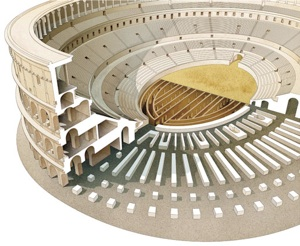
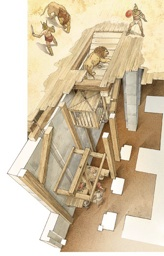
Of course, we can’t forget the sea-battles they hold in the Coliseum! They were called “naumachiae (from the Greek word for sea warfare) os simulated sea battles. Outside the Coliseum stood the Meta Sudans, a fountain in the garden of Nero that filled up his lake, where today the Coliseum is. Many roman writers (Suetonius, Cassius Dio) wrote those events. Very specific was Cassius Dio who wrote: "Titus suddenly filled this same theatre with water and brought in horses and bulls and some other domesticated animals that had been taught to behave in the liquid element just as on land. He also brought in people on ships, who engaged in a sea-fight there, impersonating the Corcyreans and Corinthians." A system of sluice gates could be used to close off water and for water pressure to reach the correct level for the arena to be flooded by four million gallons of water to a depth of five feet within seven hours. Additional work uncovered 18 sunken blocks used to hold wooden props which held up the arena's floor and which could be removed to allow the area to be used for water battles, or naumachiae. The fountain of Nero provided also the water for the utilities in the Coliseum. Everywhere in the walls there were pipes with running water. Don’t forget that there were over 50 000 spectators who had to go to the toilet.
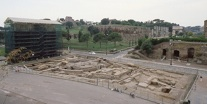
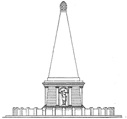
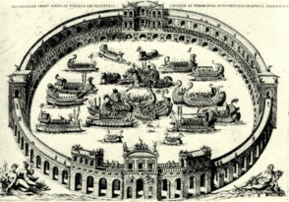
The Visitors
Asking what you would pay for a ticket for the best seats during the final of Wimbledon or the Super Bowl in America, often the answer is a few thousand £ or $. Mistake !!! Probably you pay nothing! It will be the “corporate box”, for which you have received your ticket. Rule 2 of the the Roman Empire is that “the best seats are always for free!” But as we known, there doesn’t exist nothing like a free lunch. Today, we have every year free mega-concerts on the Fori Imperiali or in the Circus Maximus. Among the performers we had Sir Elton John, Paul McCartney, Simon & Garfunkel ... and all for free. Sponsored by the largest energy-company of Italy. Not for nothing we have the highest electricity bill in Europe.
As already mentioned, the empire was structured as a Ponzi-scheme. Everything was for sale. When it was the inauguration in 80 A.D., the party lasted 100 days non-stop. A minimum of 50 000 spectators at the same time, and maybe four shifts a day, created 200 000 tickets daily at the disposal of who organized the games. If you were a good fundraiser for the emperor, he maybe would give you 8000 tickets for the opening-ceremony. Of course, you have also clients, and your best customers would get maybe 500 from your 8000 tickets. Those on their turn gave tickets away to their clients. Finally, also the Roman citizen got a ticket: we had to buy his vote. It wasn’t discrimination that they didn’t allowed women inside during the first centuries. Why would you waste a valuable ticket to a woman who had no right to vote? No return of favors .... and no ticket. Everybody new through tablets the time and the gate number of entrance. Today entering in the Coliseum is a burden. Lining up for acquiring a ticket. (click here for finding out how to skip the queues)In the Roman era, they could fill and empty the Coliseum in a half an hour. Everybody knew exactly through which gate to walk in and at what time. For sure, a ticket close to the gate of the emperor, would mean that promotion was in view. If instead, by the next game, your seat was far and high above the emperor, it would be wise to think about early retirement!
Gladiators
In the Roman time there were about 60 amphitheaters in Rome. All smaller than the Coliseum, but some of them made also history. Like the one that was located where today is the sacristy of St. Peters Basilica. There was the amphitheater of Nero. His obelisk stands now in the center of St.Peters Sq., but stood originally in the center of his amphitheater. All those minor circuses were destroyed (the victor writes the history - do you remember?), and the materials were recycled for the construction of churches a.s.o. As early said, the biggest mistake in the film “the Gladiator” was probably that the emperor came down in the arena and fought against a prisoner. It is unheard that an emperor would fight against a slave or a prisoner. He only would combat against a free man. And that made in the earlier years the difference between the Coliseum and the other minor amphitheaters. The minor circuses where for combats among prisoners and slaves. Instead, the Coliseum was mostly a combat between free man, who by choice became a gladiator. You may ask who and why? Just like today, some poor people with talent are working themselves up by becoming a professional boxer or sportsman. And they do it for fame and mostly ..... for the money.
Lets say you are young and had the ambition for becoming a gladiator. First of all: find a sponsor (today: Nike, Adidas, Coca Cola ...). In Roman time it could be a senator, governor or the emperor himself. Then you underwent an intensive training for a minimum of three years in the Ludus Magnus, the training camp for gladiators, opposite the Coliseum. Finally, you could enter the arena. Some of those gladiators became extremely rich and famous. And what would you do if the whole city was praising you as “Terminator 1,2,3 .....”, and you came at 35 to the age of retirement? Maybe the same as today: go and run for “Gòvernàtor”, and enter in (lucrative) politics.
It was said that the emperor Comodus often came down in the arena for fighting. Only possible if his adversary is a free man! The whole tradition of having combats - maybe in the final for life or dead - is going back to the early kings of Rome. There is on the forum, in front of the Curia (the senate of the Roman Empire) an excavation, where was found the lapis niger, the black stone under which was buried Ostilio Tullus. It was said that the head of this king gave its name to the second hill of Rome: caput Tullus -> Capitol. But during the rites of the archaic funerals, there would be a combat. Similar to the bull-fighting in Spain today. the underlaying idea is that if you can kill the bull, the power of the bull is going over in you. In the combat during the funeral rites, the power is going over to the man who get buried in his journey to the other world. In the Mythras cult you have to kill the bull and drink his bled. In that way, the power of the bull is going over in you. In the same way Christ said during the Last Supper: “drink My bled ...”
Often gladiators were called after the region or city of origin together with the name of their weapon. The most common was a “gladius”, a kind of a small sword. From that weapon is derived the name “Gladiator”. Others would have a netting: Retiarius (from) Veii and so on. In the combat there was always a kind of balance. If you had only a small swiss knife to fight with, you would have a lot of body-protection. In case you could kill in distance, your armor would be more reduced.
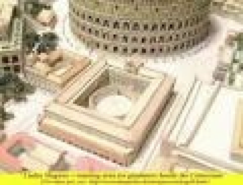
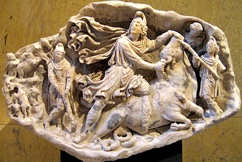
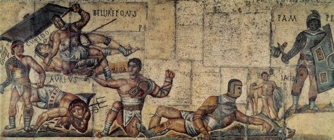
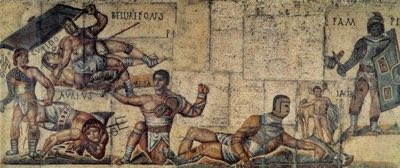
The Animals
It was said that during the first game somehow like over 5000 wild animals were killed during the combats. Today we often speak about global warming. I don’t think that WWF or Greenpace would be happy with the Romans. Nature, over the centuries knew global warming alternated by glacial periods. But for me, global warming as we know it today, is when humans interfere with nature. And the Romans were good (or bad) in it. The map below shows you the provenience of animals from all over the world. Games were a global industry. Bears, bisons from the north, horses from Spain; elephants, hippos, lions, zebras, giraffes from the north of Africa; tigers and asian elephants from Indie and so on. Every governor had to send the animals at his disposal to Rome.
As a small boy, I went often with my granny to the zoo in Antwerp. It’s located next to the entrance of the Central Station. When I asked her why they would create a zoo in the heart of a city, and not outside where was more space for those animals, she couldn’t reply. But the zoos of today right in the heart of the European historical cities are the inheritance of the nurseries for the circuses in the Roman time. Animals arrived continuously from all parts of the roman world, and they tried to breed them before they got slaughtered in the Circus. And you need them close by your circus. It is proven that the Romans extinguished at least 17 kinds of animals from their habitat. So arrived in the year 204 A.D. a letter with the message: “Your Majesty!, we caught the last lion in Egypt!” After that achievement, lions never came back in Egypt. That’s what I am calling global warming. Human mankind interfering with nature and altering it. Year after year, the Romans had to go further inland for finding their supply of fresh animals.
But the presence in the circuses of all those animals had also a political function. Can you imagine that no bears or bisons arrived in the arena? It would be a disaster! Because it meant that there were troubles in the northern provinces: and didn’t came the salt from there, over the salt route, the Via Salaria?
And the emperor often paid his soldiers their weight in salt! (from here is coming the wages we are earning: our salary.) But troubles in the north meant no bears or bisons, but neither salt: and something like that could cause an uproar in the army. The same for the lions of Egypt: no lions ... no food from the delta of the Nile! As long all the very different animals were present in the circus, the emperor could show to the senators and the mob that he had still a grip over his empire.
What happened with the dead animals? Simply: first of all a big barbecue. It was hold in the street behind the Arch of Constantine. Oh! Irony of the history! At the end of that street, today, we have the FAO, the Food & Agriculture Organization of the United Nations. They are supplying food to the third world countries: Panem et circenses, as Juvenal mentioned it in his satire X, line 81. Juvenal here makes reference to the Roman practice of providing free wheat to Roman citizens as well as costly circus games and other forms of entertainment as a means of gaining political power. But they made good use of every part of the animal: the bones for making lime, the skins for cloths or for the fundaments of buildings in wet areas a.s.o. The whole of the old St. Peters Basilica, build by the emperor Constantine is build on the skins/leather of animals. The same technique was applied for building the tower of Pisa.
That beautiful, gorgeous, white marble and ... totally useless tower was build (because it has no defense reason) to show the world how wealthy Pisa was. And because they were so wealthy, more people came to live in Pisa and more groundwater was consumed. The level of the groundwater went down (together with a climate change at the end of the Renaissance), the tower came at a distance of three miles from the sea.... and the leather underneath in the foundation dried up. The tower started leaning. Today, the have put concrete under the weakest parts, but the other side is still resting op the leather. Today it is not allowed to use groundwater in a distance of four miles around the Tower.
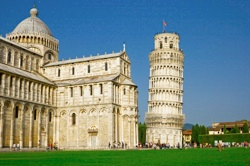
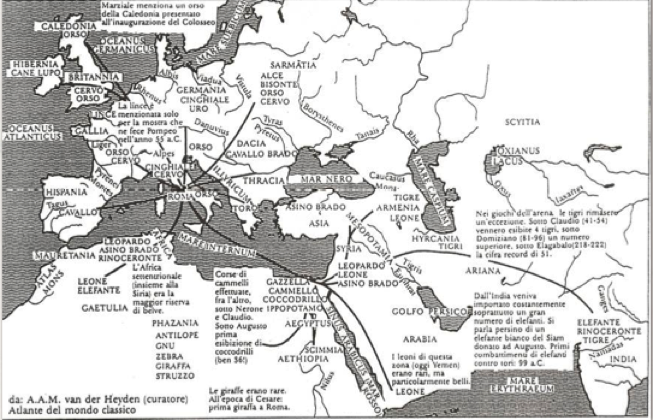
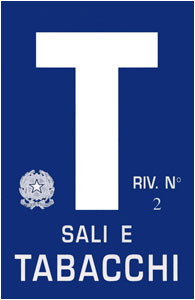
Medicines
War is among the best time for new inventions. It pushes humans to the edge in order to remain one step in front of the other. And the circuses of the Roman time are no exception. The whole tradition, seeing the crowds putting their thumbs down, showing that they didn’t want mercy but bled, maybe happened in the smaller circus, but not in the Coliseum with professionals. The gladiators in the Coliseum were far to expensive to waist them. The sponsors would not agree. If all your professional gladiators are dead the first day, what would you do the next days? Battle for life or dead would maybe be done for the final. Only when the vestal Virgins, the only women who could attempt the games in the beginning, put their thumbs down, that would have been final.
So, the Romans kept their professional gladiators in the best condition as possible. When the Roman Empire expanded into Greece, many Greek doctors came to Italy and Rome. Some of these were prisoners of war and could be bought by wealthy Romans to work in a household. Many of these doctors became valuable additions to a household. It is known that a number of these men bought their freedom and set up their own practices in Rome itself. After 200 BC, more Greek doctors came to Rome but their success at the expense of Romans did generate some mistrust. Plinus mistrusted greek doctors: "I pass over many famous physicians men like Cassius, Calpetanus, Arruntius and Rubrius. 250,000 sesterces were their annual incomes from the emperors. There is no doubt that all these physicians in their hunt for popularity by means of some new idea, did not hesitate to buy it with our lives. Medicine changes everyday, and we are swept along on the puffs of clever brains of the Greeks…..as if thousands of people do not live without physicians – though not, of course, without medicine.” But, further, Pliny the Elder describes a.e. the cultivation and industrial and medical use of cannabis in his encyclopedic work: In the Naturalis Historia. XII–XXVII he describes Botany, including agriculture, horticulture and pharmacology. In book XIX and XX Pliny describes the industrial, medical use and cultivation of cannabis. More in my article about medicines in Roman time.
It was even said that the romans had the knowledge of penicillin. They applied fungus on open wounds and covered them with spiderwebs, that they used as sterile gazing. Or they applied vinegar. A lot of that information got lost in Europe after the decline of the Roman Empire in 476. But that information was still present in the library of Constantinople. When that library was bought by the Medici and came to Florence at the end of the the 14th century, a revival was born: The renaissance. Vesalius dissected bodies of dead people and wrote his work on anatomy, Dodoens wrote his book on medical herbs, inspired by Pliny the Elder. Those remedies would last until far into the 20th century! Toothpaste today still has often sage as one of the ingredients. Something the Romans used for keeping their teeth healthy.
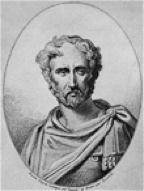

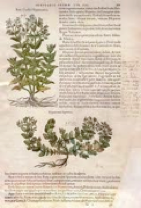
Conclusion
The thirst after bled by humans is of all times.But sure, the Romans took it to a level never seen before or after. It showed their power of a global economy. Many thinks I forgot to mention, such as the huge gambling that surrounded the games (and often fixed!). The Coliseum, symbol of the worldwide power of the Romans, held the germs of their defeat. In the short time the Empire existed, the population raised from a few hundred thousand to more than a million. And people didn’t came to Rome seeking for work: No, it was the “panem et circenses”, the “bread and games” that attracted them.
You would say that you can compare it with the social welfare we have in Europe. In a city like Brussels, every year you add through immigration a medium seized town of 27 000 inhabitants. Let say you are an immigrant of one of the northern African countries. After 5 years being in Brussels, you can apply for a passport. As soon you have it, you can call your wife and ask her to come over, with children. For each minor you will receive a benefit of the government, and if your family is large enough, housing and utilities paid by the government. Because they don’t speak the language, they will be unemployed; but also that is provided by the government. Today 60 % of the younger immigrants in Brussels is unemployed. Our social system is cracking on all sides and will collapse. As long there is an expanding economy of a minimum of 3 % of the BNP, it remains sustainable. But since 2008 we don’t have that anymore. Will that be the end of the European social model?
Similar what happened in Rome: The emperor provided food deliveries, entertainment, housing, water-supply, and all the rest.This explains the rapid growth of Rome. In a few years a city of 150 000inhabitants, became a city of over one million. And they didn’t come to Rome for working! If the emperor didn’t want an uproar in the city, he had to provide housing, food and entertainment. Being the roman economy a Ponzi-scheme, as long the empire expanded, new territories were added, there was no problem. More jobs for sale and more revenues for Rome. But once the empire started shrinking, the decline came very fast. Sic transit gloria mundi! For a while they tried to keep up the same lifestyle. But there were no prisoners of war anymore, who created the workforce. That is the time that we had the worst christian prosecutions, like those around 300 of the Emperor Diocletianus, who build his public baths by enslaving the christians.
It’s a fearing prospect. Will we find the time and the means and political will to stop it ? History will prove. Sorry that I am finishing with a sad note. If you like to comment it, please don’t hesitate.
Frank.
